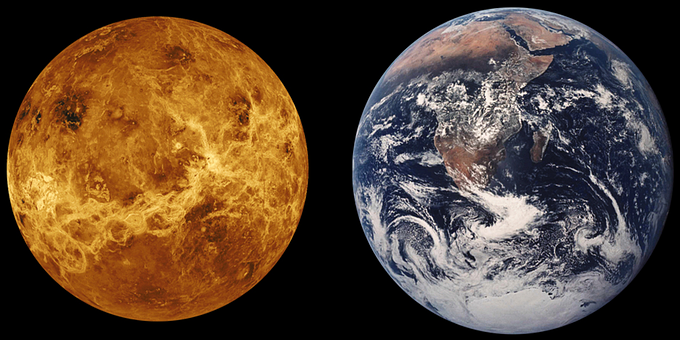Venus has 92 times greater atmospheric pressure than earth's!!
VENUS

INTRODUCTION
What's Venus like?
Venus may be finest described with two phrases: cloudy and scorching. All the floor(surface) of Venus is continually coated by clouds. These clouds are made up largely of carbon dioxide which has a greenhouse effect in maintaining the Sun's warmth like an enormous blanket. Consequently Venus is the most popular planet in our photo voltaic system(solar system). It's even hotter than Mercury, which is way nearer to the Solar.
Venus is a terrestrial planet like Mercury, Earth, and Mars. This implies it has a tough rocky floor. Its geography is considerably like Earth's geography with mountains, valleys, plateaus, and volcanoes. It's fully dry, nevertheless, has lengthy rivers of molten lava and hundreds of volcanoes. There are over 100 large volcanoes on Venus which can be every 100km or extra throughout.
Why venus has so high atmospheric pressure?
Because Venus has such a dense atmosphere which is some 100 times thicker than the earth's. Evidently, Venus is sufficiently close to the Sun that the little carbon dioxide it had in its early, Earth-like atmosphere caused the surface to warm up and leach out more carbon dioxide into the atmosphere.
How does Venus compare to Earth?

Venus is similar to Earth in dimension, mass, and gravity. It's generally known as Earth's sister planet. After all, Venus' dense environment and intense warmth makes Venus very totally different in some ways. Water, an important a part of Earth, is not discovered on Venus.
How can we find out about Venus?
Since Venus is so simply seen without using a telescope there is no information that who might have first seen the planet. Some historic civilizations thought it was two planets or vibrant stars: a "morning star" and an "night star". Within the sixth century BC, a Greek mathematician named Pythagoras famous that it was the identical planet. It was Galileo within the 1600's who discovered that Venus orbited the solar(sun).
Since the space age began there have been many probes and spacecraft despatched to Venus. Some spacecraft have even landed on Venus and have despatched us again info on what the floor(surface) of Venus is like underneath the clouds. The primary spacecraft to land on the floor was Venera 7, a Russian ship. Later, from 1989 to 1994, the Magellan Probe used radar to map Venus' floor in nice element.
Since Venus is contained in the Earth's orbit, the brightness of the Sun makes it troublesome to see from the Earth in the course of the day. Nonetheless, simply after sundown or simply earlier than dawn Venus turns into the brightest object within the sky. It's usually the brightest object within the evening sky aside from the moon.
Venus is the brightest planet in our evening sky, however what are the details about this planet?
Try these prime fifteen attention-grabbing details about Venus!
- Venus and Mercury are the only planets inside our photo voltaic System(solar system) to not have any moons orbiting them.
- Venus is the only planet in our photo voltaic system to rotate clockwise! Resulting from its very slow rotation, specialists think that at one time far up to now, something might have collided with the planet that modified its rotation.
- After the Sun and the Moon, Venus is the following brightest object in our evening sky.
- There are extra volcanoes on the floor of Venus then there are on some other planet inside our Photo voltaic System. We're not sure on how energetic these volcanoes are, if in any respect.
- Venus may be vibrant sufficient within the evening sky to cast shadows! Most of these shadows are often known as “Venusian shadows”!
- A day on Venus would be 243 Earth days, while a complete yr on Venus would last for 224.7 days – making a yr on Venus shorter than a day!
- Because of the thick environment on Venus, temperatures on the floor can attain as much as a staggering 470 levels Celsius!
- The traditional Babylonians used to trace Venus’ path through the skies that date again so far as 1600 BC.
- Venus is called after the Roman goddess of affection and wonder.
- Venus is the only planet named after a feminine.
- Venus is usually mentioned to be Earth’s twin sister, as they're each of comparable sizes, mass and density.
- The floor of the planet is extraordinarily dry as a result of floor temperature. If there have been any liquid there, the warmth would trigger the liquid to boil away immediately.
- The planet’s environment is generally made up from Carbon Dioxide.
- Maat Mons, Venus’ largest volcano, stands at 5 miles high!
0 Comments:
Post a Comment
pls comment which topic you would like to read next